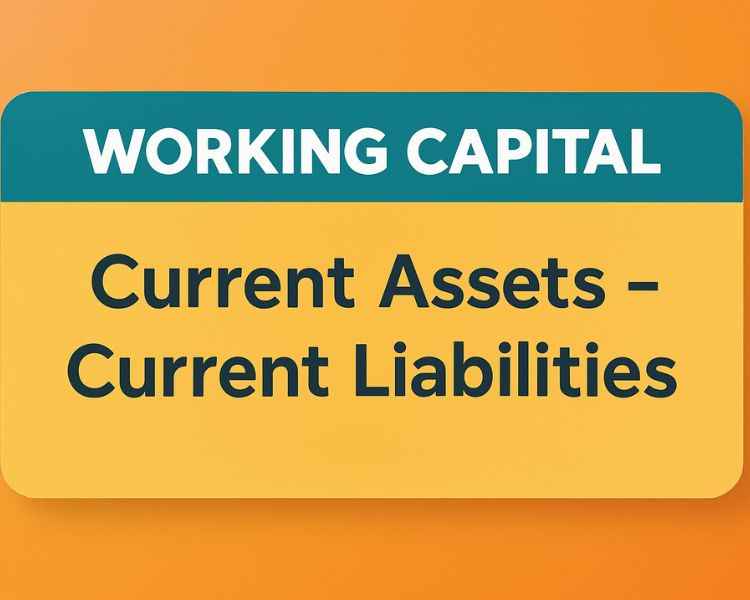Definition of Working Capital (Net Working Capital – NWC)
Working capital, also known as Net Working Capital (NWC), is the difference between a company’s current assets (such as cash, accounts receivable, and inventory) and current liabilities (such as accounts payable and short-term debt).
What Is Working Capital?
Working capital is a financial metric that reflects a company’s ability to cover short-term obligations. It is the difference between current assets and current liabilities, playing a crucial role in determining business liquidity and operational efficiency.
Understanding Working Capital
A well-managed working capital ensures that a business can pay off debts, fund daily operations, and invest in future growth without financial strain. It acts as a financial cushion, allowing companies to handle unexpected expenses, take advantage of business opportunities, and maintain smooth operations. Proper working capital management helps businesses avoid liquidity issues, ensuring they have enough cash to cover short-term obligations like payroll, inventory purchases, and supplier payments.
On the other hand, poor working capital management can lead to cash flow shortages, making it difficult for a company to meet its financial commitments. This may result in delayed payments to suppliers, reduced creditworthiness, and even an inability to seize profitable opportunities. In extreme cases, prolonged negative working capital can push a business toward financial distress, forcing it to take on high-interest debt or liquidate assets to stay afloat. Therefore, understanding and effectively managing working capital is essential for the long-term financial stability and growth of any business.
Working Capital Formula: How to Calculate It?
The standard formula to calculate working capital is:
Working Capital = Current Assets − Current Liabilities

Example Calculation
If a company has $600,000 in current assets and $400,000 in current liabilities, the working capital is: 600,000−400,000=200,000600,000 – 400,000 = 200,000600,000−400,000=200,000
A positive working capital of $200,000 indicates financial stability, while a negative figure suggests potential liquidity risks.
Positive vs. Negative Working Capital: What It Means for a Business
| Positive Working Capital | Current assets exceed current liabilities | Strong liquidity, financial stability, and ability to invest in growth |
| Negative Working Capital | Current liabilities exceed current assets | Possible cash flow issues, delayed payments, and financial pressure |
Key Takeaway
- Positive working capital allows a business to expand and meet obligations without stress.
- Negative working capital isn’t always bad but requires careful management.
Key Components of Working Capital
- Current Assets: Cash, accounts receivable, inventory, and short-term investments.
- Current Liabilities: Accounts payable, short-term loans, and accrued expenses.
Limitations of Working Capital
While working capital is an essential financial metric, it has some limitations:
- Constantly Changing Values:
- Working capital fluctuates frequently as businesses operate. By the time financial reports are prepared, the numbers may already be outdated, leading to misinterpretation.
- Type of Assets Matters:
- Not all current assets are equally liquid. A company with positive working capital but a high amount of accounts receivable may struggle with cash flow if customers delay payments.
- Risk of Asset Devaluation:
- Certain assets, such as inventory and accounts receivable, can lose value quickly due to market changes, theft, or customer defaults, affecting actual liquidity.
- Hidden or Unrecorded Debt:
- In fast-paced industries or mergers, undisclosed financial obligations, misplaced invoices, or unprocessed agreements may lead to incorrect working capital calculations.
- Not a Standalone Profitability Indicator:
- Positive working capital doesn’t always mean a business is profitable. Other financial factors, such as high operating costs or declining sales, can still lead to losses.
- Industry-Specific Differences:
- Some industries, such as grocery retail, operate efficiently with negative working capital due to fast inventory turnover, whereas capital-intensive businesses require high working capital.
Special Considerations for Working Capital Management
Companies must actively manage their working capital to maintain financial stability. Important factors to consider include:
- Optimizing Receivables: Implementing faster payment collection strategies.
- Managing Inventory Smartly: Avoiding overstocking to prevent tied-up capital.
- Negotiating Supplier Terms: Extending payable periods to maintain better cash flow.
- Monitoring Liabilities: Keeping track of financial obligations to avoid unexpected shortages.
Example of Working Capital in Action
A manufacturing company with:
- $1 million in current assets
- $600,000 in current liabilities
1,000,000−600,000=400,0001,000,000 – 600,000 = 400,0001,000,000−600,000=400,000
With $400,000 in positive working capital, the company can cover its short-term obligations and reinvest in business expansion.
Is Negative Working Capital Always a Problem?
Not necessarily. Some industries, especially those with fast cash conversion cycles, thrive with negative working capital. For example, large retailers receive payments from customers instantly while paying suppliers later, keeping operations efficient despite negative working capital. However, industries with slow inventory turnover may struggle under similar conditions.
How Can a Company Improve Its Working Capital?
- Faster Invoice Collection: Offering early payment discounts to customers.
- Better Supplier Negotiations: Extending payment deadlines where possible.
- Inventory Optimization: Preventing overstocking and avoiding excess tied-up capital.
- Expense Management: Reducing unnecessary costs to maintain liquidity.
The Bottom Line: Why Working Capital Matters
A company’s ability to manage working capital effectively determines its financial health. A business with a strong working capital position can meet obligations, invest in growth, and maintain stability, whereas poor working capital management can lead to liquidity crises. Regular monitoring and smart financial strategies are essential for sustaining healthy operations.